BeoVision 8202
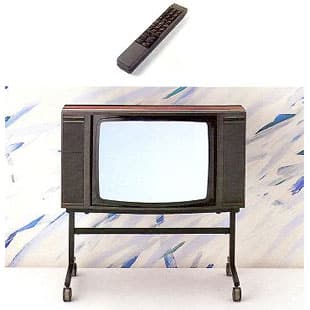

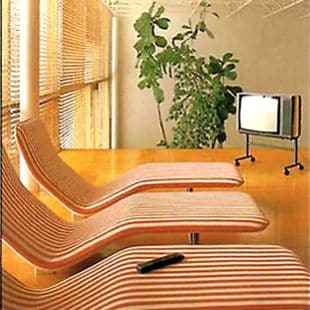
“As yet, none of us need 32 TV channels, let alone 100. But satellite re-broadcasting systems and cable TV, including regional and community networks, might soon change that” (1983 catalogue)
Therefore, Bang & Olufsen equipped all the luxury Beovision models with an advanced digital tuner that had the capacity for receiving 100 UHF channels, 32 of which could be stored in the set’s microcomputer memory for instant recall at the touch of a button.
Beovisions 5502, 7702, 8802 and 9002 all shared the same advanced chassis design and offered the same user-benefits. They were true “luxury” sets because many ‘extras’ offered by other companies, were given as standard by Bang & Olufsen.
The Beovision Video Terminal supplied with Beovisions 5502, 7702, 8802 and 9002 offered a plethora of operational benefits. In addition there was also an advanced ‘tune and store’ function that allowed you to operate the automatic tuning system from the comfort of your chair.
One touch of the ‘tune’ button started the digital tuner scanning the wavelengths of the UHF band. When it found a station, it stopped – giving you the opportunity to either reject or accept it. If it was an unsatisfactory reception from a distant transmitter (or simply a station you don’t like!), you just pressed ‘tune’ again to continue the search. When you found a station you enjoy, on a channel giving a good, clear reception, you could instruct the set’s microcomputer to remember that transmission frequency by pressing ‘store’ followed by your own choice of pre-set programme number (e.g. for BBC2 you might designate pre-set number 2). Thereafter, whenever you wanted to watch BBC2, you simply touch button ‘2’ on your remote Terminal.
Up to 32 different TV stations could be located and stored in this way, so your Beovision really is ‘future-safe’ because it has plenty of spare capacity to accommodate new programme sources as and when they come ‘on stream’.
The latest type of Beovision Video Terminal also had a button marked ‘sound’. This was only effective with Bang & Olufsen stereo TVs – Beovision 7802 and Beovision 8902.
Beovision 5502 had a 50cm screen and measured 62cm wide, 40cm high (71.5cm including stand) and 39cm deep.
Beovision 7702 had a 22″ screen. Dimensions were 67.5cm wide, 43.5cm high (76cm including stand) and 41.5cm deep.
Beovision 8802 had a 26″ screen and measured 77cm wide, 49cm high (80cm including stand) and 45.5cm deep.
All three models had slim cabinets finished in a choice of natural teak or rosewood. White finish was available to special order.
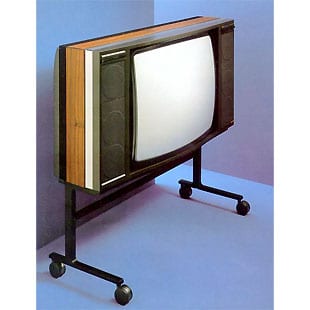
Beovisions that put the future at your fingertips
As yet, none of us need 32 TV channels, let alone 100. But satellite re-broadcasting systems and cable TV, including regional and community networks, may in the future change that.
Therefore, Bang & Olufsen equipped all their luxury Beovision models with an advanced digital tuner that had the capacity for receiving 100 UHF channels, 32 of which could be stored in the set’s microcomputer memory for instant recall at the touch of a button.
The real boon for most viewers is that you could locate, store and recall any of these stations without leaving your armchair. All you had to do was to touch a key on the Beovision Video terminal. So although the company gave their “future-safe” luxury TV range more micro-electronics, more features and more connection possibilities than ever before, they had, at the same time, made all this complex technology even more accessible – instantly. To borrow a phrase from the computer industry, Bang & Olufsen’s ’02-Series’ TVs were (and still are) extremely “user-friendly”.
Beovisions 5502, 7702, 8802 and 9002 all shared the same advanced chassis design and offered the same user-benefits. They were true “luxury” sets because all the features and facilities which, in other brands, are offered as ‘extras’ were offered as standard on Bang & Olufsen sets.
The Beovision Video Terminal supplied with Beovisions 5502, 7702, 8802 and 9002 offered a plethora of operational benefits. In addition there was also an advanced ‘tune and store’ function that allowed you to you operate the automatic tuning system from the comfort of your chair.
One touch of the ‘tune’ button started the digital tuner scanning the wavelengths of the UHF band. When it found a station, it stopped – giving you the opportunity to either reject or accept it. If it was an unsatisfactory reception from a distant transmitter (or simply a station you didn’t like!), you just pressed ‘tune’ again to continue the search. When you found a station you enjoyed, on a channel giving a good, clear reception, you could instruct the set’s microcomputer to remember that transmission frequency by pressing ‘store’ followed by your own choice of pre-set programme number (e.g. for BBC2 you might designate pre-set number 2). Thereafter, whenever you wanted to watch BBC2, you simply touched button ‘2’ on your remote Terminal.
Up to 32 different TV stations could be located and stored in this way, so your Beovision really was ‘future-safe’ because it had plenty of spare capacity to accommodate new programme sources as and when they come ‘on stream’.
The (then) latest type of Beovision Video Terminal also had a button marked ‘sound’. This was only effective with Bang & Olufsen stereo TVs – Beovision 7802 and Beovision 8902, for example.
In the days before widescreen, active speakers and Dolby Digital modules, the catalogue of 1985 stated that: “it would be foolish to spend more money that you needed. Why pay for multiple features and facilities when all you wanted was the best possible picture quality, good sound and instant remote access to all available UHF TV channels?”. Unfortunately, those days have long since gone!
The most sensible and economic answer to such a modest set of demands was right there, it stated, in the ‘traditional’ Beovision 5102, 7102 and 8102. All three sets were identical; it was only the size of the tubes that differed. You obtained the same type of picture tube as in the luxury sets (the Beovision 5502, 7702 and 8802 range, for example): automatic colour balance, high reliability… and a bright, clear, natural-looking picture. Sound quality was 6 watts RMS.
The remote control was identical too – the Beovision Video Terminal was used on all of the sets. You could tune across the entire UHF band and store up to 32 station frequencies in the set’s microcomputer memory for instant recall. The Beovision Video Terminal made it easy to control.
Sound output was 6 watts. Connections were provided for an extension speaker and a tape recorder; the tape socket had an alternative function – you could use it to feed the TV sound through a hi-fi system. And connecting a Loop Amplifier would allow a person with a hearing aid to enjoy TV sound more fully.
All three models could be supplied with or without Teletext facilities. The slim-line cabinets were identical in design but offered an alternative in materials and finish: a furniture-crafted wood cabinet finished in rich-grained natural teak or rosewood; Beovision 5102 was also finished in natural grey.
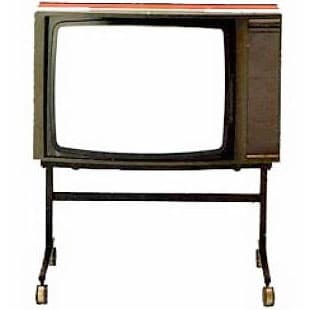
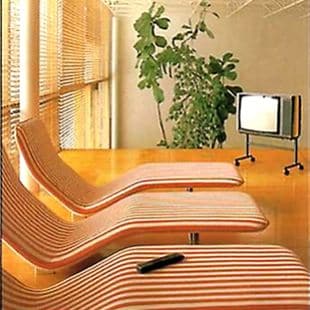
“As yet, none of us need 32 TV channels, let alone 100. But satellite re-broadcasting systems and cable TV, including regional and community networks, might soon change that” (1983 catalogue)
Therefore, Bang & Olufsen equipped all the luxury Beovision models with an advanced digital tuner that had the capacity for receiving 100 UHF channels, 32 of which could be stored in the set’s microcomputer memory for instant recall at the touch of a button.
The real boon for most viewers is that you could locate, store and recall any of these stations without leaving your armchair. All you had to do was touch a key on the Beovision Video terminal. So although B&O gave its “future-safe” luxury TV range more micro-electronics, more features and more connection possibilities than ever before, they made, at the same time, all the complex technology even more accessible – instantly. To borrow a phrase from the computer industry, Bang & Olufsen’s ’02-Series’ TVs were “user-friendly”.
Beovisions 5502, 7702, 8802 and 9002 all shared the same advanced chassis design and offered the same user-benefits. They were true “luxury” sets because many ‘extras’ offered by other companies, were given as standard by Bang & Olufsen.
The Beovision Video Terminal supplied with Beovisions 5502, 7702, 8802 and 9002 offered a plethora of operational benefits. In addition there was also an advanced ‘tune and store’ function that allowed you to operate the automatic tuning system from the comfort of your chair.
One touch of the ‘tune’ button started the digital tuner scanning the wavelengths of the UHF band. When it found a station, it stopped – giving you the opportunity to either reject or accept it. If it was an unsatisfactory reception from a distant transmitter (or simply a station you don’t like!), you just pressed ‘tune’ again to continue the search. When you found a station you enjoy, on a channel giving a good, clear reception, you could instruct the set’s microcomputer to remember that transmission frequency by pressing ‘store’ followed by your own choice of pre-set programme number (e.g. for BBC2 you might designate pre-set number 2). Thereafter, whenever you wanted to watch BBC2, you simply touch button ‘2’ on your remote Terminal.
Up to 32 different TV stations could be located and stored in this way, so your Beovision really is ‘future-safe’ because it has plenty of spare capacity to accommodate new programme sources as and when they come ‘on stream’.
The latest type of Beovision Video Terminal also had a button marked ‘sound’. This was only effective with Bang & Olufsen stereo TVs – Beovision 7802 and Beovision 8902.
Beovision 5502 had a 50cm screen and measured 62cm wide, 40cm high (71.5cm including stand) and 39cm deep.
Beovision 7702 had a 22″ screen. Dimensions were 67.5cm wide, 43.5cm high ( 76cm including stand) and 41.5cm deep.
Beovision 8802 had a 26″ screen and measured 77cm wide, 49cm high (80cm including stand) and 45.5cm deep.
All three models had slim cabinets finished in a choice of natural teak or rosewood. White finish was available to special order.
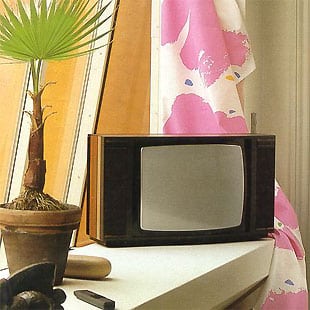
Beovisions that put the future at your fingertips
As yet, none of us still need 32 terrestrial TV channels, let alone 100. But satellite re-broadcasting systems and cable TV, including regional and community networks, may change that.
Bang & Olufsen, in the mid-1980s equipped all their luxury Beovision models with an advanced digital tuner that had the capacity for receiving 100 UHF channels, 32 of which could be stored in the set’s microcomputer memory for instant recall at the touch of a button.
The real boon for most viewers is that you could locate, store and recall any of these stations without leaving your armchair. All you had to do was to touch a key on the Beovision Video terminal. So although B&O gave their “future-safe” luxury TV range more micro-electronics, more features and more connection possibilities than ever before, they had, at the same time, made all this complex technology even more accessible – instantly. To borrow a phrase from the computer industry, Bang & Olufsen’s ’02-Series’ TVs were “user-friendly” (1983 catalogue).
In 1985, to celebrate Bang & Olufsen’s diamond anniversary – 1925 – 1985 – a special edition of Beovision 7802 was released. The television was finished in a dark veneer (ivory-coloured) in place of the standard teak and rosewood finishes.
A small ’emblem’ was included on the top right-hand side to commemorate this special occasion.
Beovisions 5502, 7702, 8802 and 9002 all shared the same advanced chassis design and offered the same user-benefits. They were true “luxury” sets because all the features and facilities which, in other brands, were offered as ‘extras’ were standard in Bang & Olufsen sets.
The Beovision Video Terminal supplied with Beovisions 5502, 7702, 8802 and 9002 offered a plethora of operational benefits. In addition there was also an advanced ‘tune and store’ function that allowed you to operate the automatic tuning system from the comfort of your chair.
One touch of the ‘tune’ button started the digital tuner scanning the wavelengths of the UHF band. When it found a station, it stopped – giving you the opportunity to either reject or accept it. If it was an unsatisfactory reception from a distant transmitter you just pressed ‘tune’ again to continue the search. When you found a station on a channel that offered good, clear reception, you could instruct the set’s microcomputer to remember that transmission frequency by pressing ‘store’ followed by your own choice of pre-set programme number (e.g. for BBC2 you might designate pre-set number 2). Thereafter, whenever you wanted to watch BBC2, you simply touched button ‘2’ on your remote Terminal.
Up to 32 different TV stations could be located and stored in this way, so your Beovision really was ‘future-safe’ because it had plenty of spare capacity to accommodate new programme sources as and when they came ‘on stream’.
This latest type of Beovision Video Terminal also had a button marked ‘sound’. This was at that time only effective with Bang & Olufsen stereo TVs – Beovision 7802 and Beovision 8902.
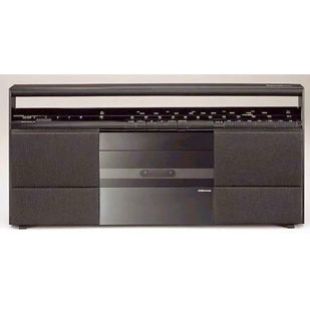
Small, compact and elegant, Beosystem 10 was the ideal companion when you were away from a main audio system.
It offered stereo radio with FM and AM/LW reception with three pre-set FM stations. The cassette recorder played every type of tape with the built-in stereo speakers providing excellent sound quality. There was also an optional wall bracket, and you could connect a turntable or extra cassette recorder, external speakers and Form 1 or Form 2 headphones.
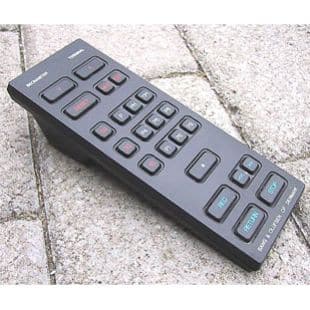
The optional remote for the Beomaster 6000, the confusingly named Beomaster terminal would only really work the Beomaster 6000 though it would work some of the functions of the Beomaster 8000. For this remote to work, the Beomaster 6000 required the optional IR module to be fitted.
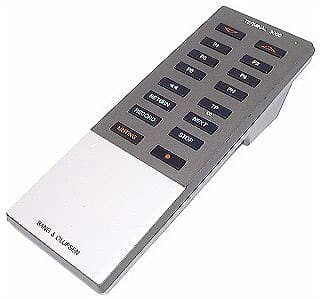
An infra red controller for use with the Beosystem 3000, the Terminal 3000 was a simple one way remote allowing selection of source and volume and a limited amount of control of the sources. This era of controls tended to be specific to one particular device ad were superseded by the Beolink 1000 type remote which provided a common remote for all products.